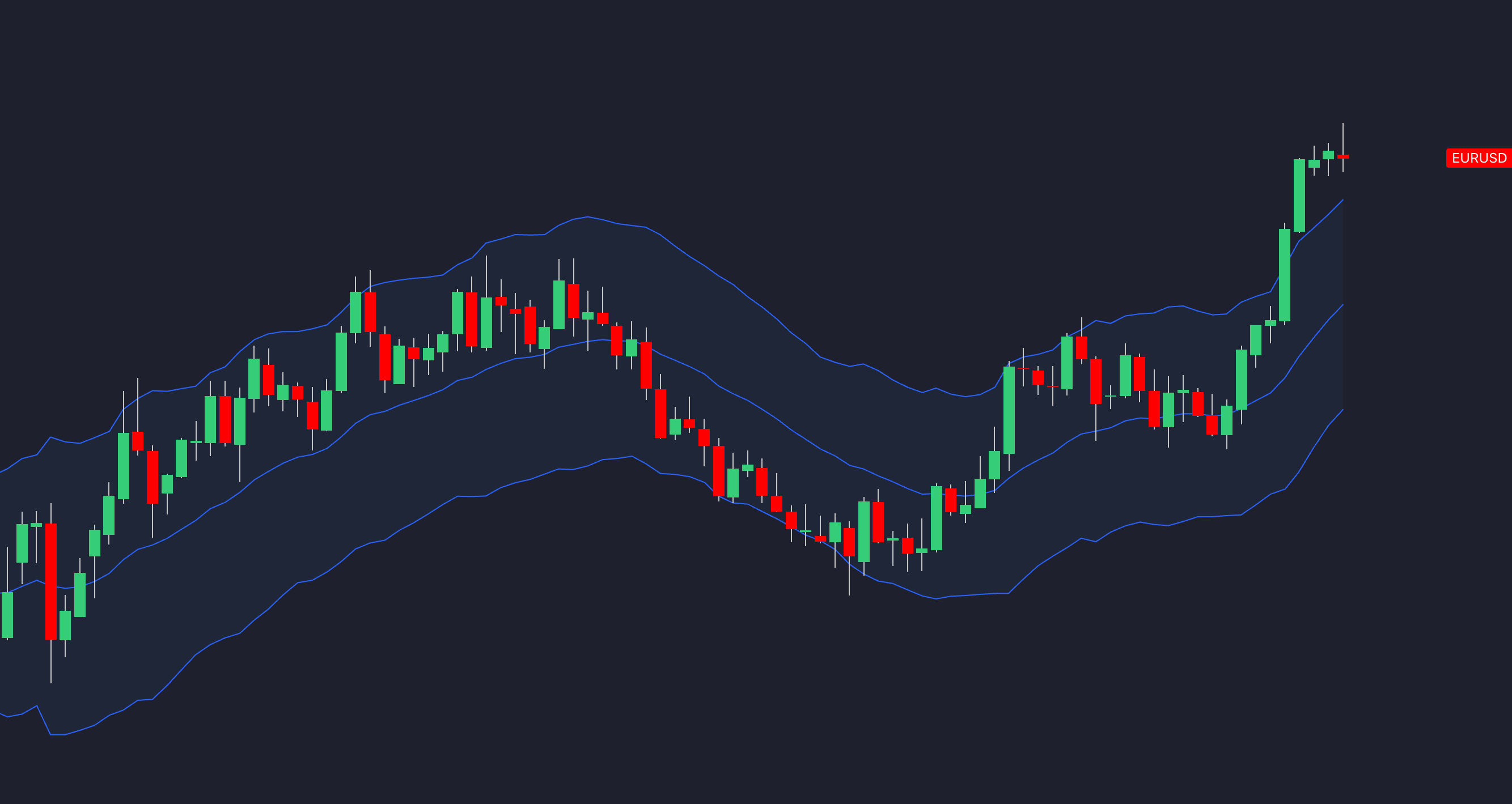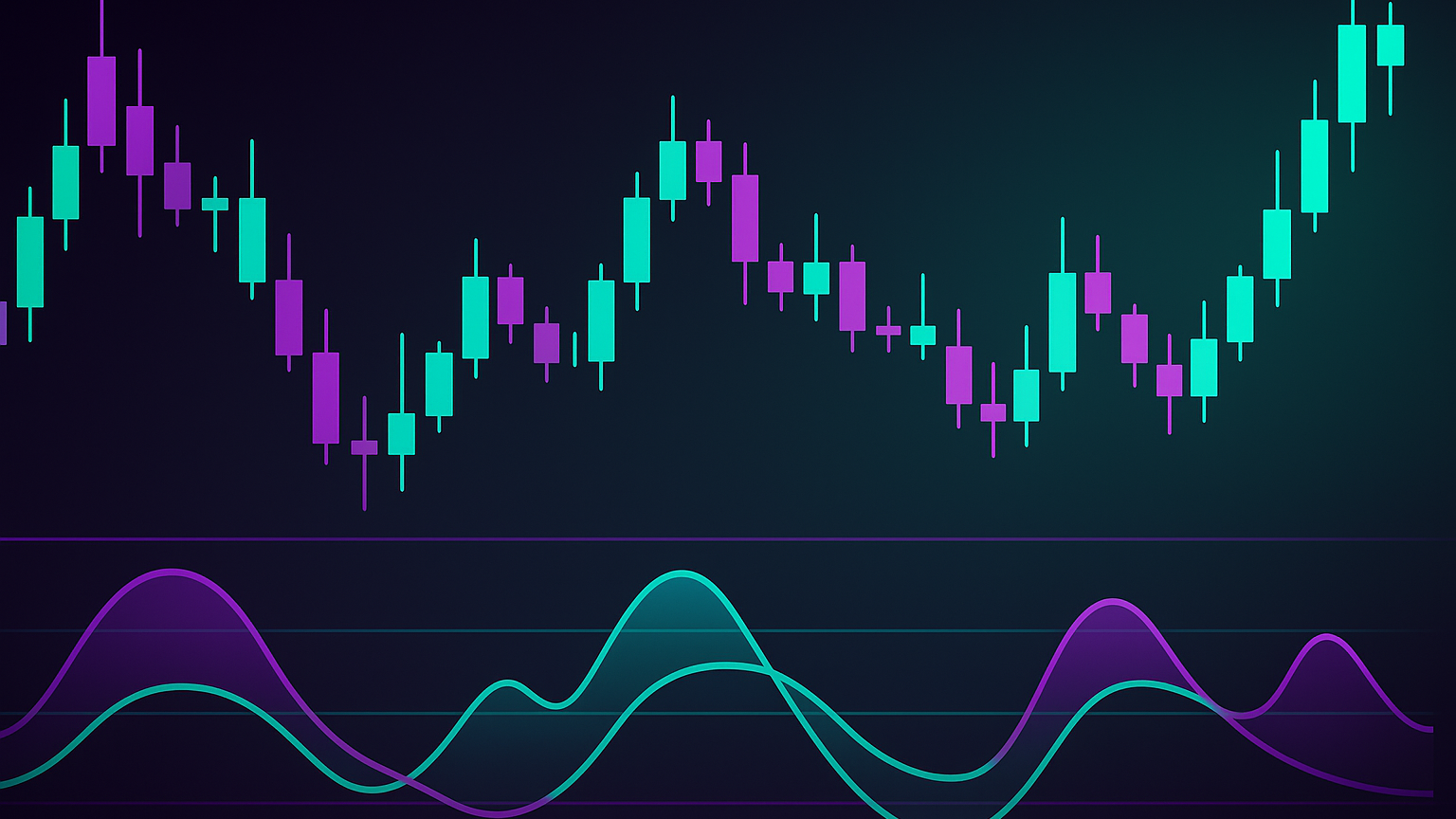Learn how to utilize Keltner Channels for trading, including trend identification, volatility assessment, and effective strategies.
The Keltner Channel is a technical analysis tool that helps traders understand market trends and volatility. It uses three components: a middle line (20-period EMA) and two bands based on the Average True Range (ATR) from LuxAlgo’s free Library. Here's why it's useful:
- Identify Trends: The channel's slope shows if the market is trending up or down.
- Spot Volatility: Band width expands with high volatility and contracts with low volatility.
- Dynamic Support/Resistance: The bands act as flexible levels for entry and exit points.
How It Works:
- Middle Line: 20-period EMA tracks price trends.
- Upper Band: EMA + (2 × ATR).
- Lower Band: EMA − (2 × ATR).
Key Strategies:
- Breakouts: Trade when price moves beyond the bands.
- Trend Following: Use the middle line as a guide for uptrends or downtrends.
- Reversals: Look for price bouncing near the bands. Pairing a momentum oscillator like the Ultimate RSI can confirm overbought or oversold conditions.
Adjust settings (EMA period, ATR multiplier) to fit your trading style, and combine with other indicators like RSI or MACD for better accuracy. Avoid using this tool in flat markets or without considering broader market context.
LuxAlgo Library users often complement the Keltner Channel with the Chandelier Exit Oscillator to visualize ATR-based trailing stops and confirm volatility shifts.
Keltner Channel Trading Strategy (TradingView Indicator)
How Keltner Channels Work
Keltner Channels are a powerful tool for identifying trends and gauging market volatility. By using volatility-based bands, this indicator helps traders track price movements and spot potential opportunities. Let’s break down how it works and how the components come together to form the channel.
Channel Calculation Method
The Keltner Channel is built from three key elements that offer a detailed snapshot of market activity. At its core is the middle line, calculated as a 20-period Exponential Moving Average (EMA) of closing prices. The upper and lower bands are then plotted at a fixed distance from this EMA, determined by a multiple of the Average True Range (ATR).
Here’s a closer look at the formulas:
| Component | Formula | Standard Setting |
|---|---|---|
| Middle Line | 20-period EMA | Based on closing prices |
| Upper Band | EMA + (2 × ATR) | 2 ATR multiplier |
| Lower Band | EMA − (2 × ATR) | 2 ATR multiplier |
The ATR is typically calculated over 10 or 20 periods, but this can be adjusted depending on the asset being analyzed. The standard 2× ATR multiplier ensures the bands capture most price movements while filtering out minor fluctuations.
Reading Volatility Bands
The Keltner Channel’s bands offer valuable insights into market behavior:
- Band Expansion: When the bands widen, it signals increased volatility and strong trend momentum.
- Band Contraction: Narrower bands indicate reduced volatility and possible market consolidation.
- Price Position: If prices consistently touch or move above the upper band, it suggests bullish momentum. Conversely, frequent interaction with the lower band points to bearish pressure.

The slope of the channel also provides clues about the trend direction. An upward slope indicates bullish trends, while a downward slope highlights bearish momentum. Additionally, the bands act as dynamic support and resistance levels, helping traders identify potential entry and exit points. For traders who prefer visual trailing stops, the Chandelier Exit Oscillator can serve as a complementary ATR-based overlay.
Understanding these mechanics is essential for using Keltner Channels effectively in trading strategies.
Trading with Keltner Channels
This section explores how to use Keltner Channels to trade breakouts, follow trends, and identify potential reversals.
Trading Breakouts
Breakout trading focuses on price movements that push beyond the channel's bands, signaling the start or continuation of a trend.
Bullish Breakouts:
- Wait for the price to close above the upper band.
- Consider entering a long position.
Bearish Breakouts:
- Wait for the price to close below the lower band.
- Consider entering a short position.
"Breakouts from the Keltner Channel act as strong hints where the price is running off to next."
After these breakouts, the channel's structure can help confirm the direction of the emerging trend.
Following Trends
Once a breakout is identified, the Keltner Channel's slope and position can confirm the trend's direction and strength. The middle line, an exponential moving average, serves as a guide. In an uptrend, prices typically stay above this line, while in a downtrend, they remain below it.
| Market Condition | Price Behavior | Trading Approach |
|---|---|---|
| Uptrend | Price stays above the middle line | Look for buying opportunities on pullbacks toward the middle line. |
| Downtrend | Price stays below the middle line | Look for selling opportunities on rallies toward the middle line. |
| Strong Trend | Channel slope aligns with trend direction | Trade in the direction of the trend. |
Trading Reversals
When the market isn’t dominated by breakouts or trends, reversals may come into play. If the price reaches the upper or lower bands, it could indicate overbought or oversold conditions. A reversal signal often occurs when the price moves in the opposite direction after stabilizing near these boundaries. To confirm a potential reversal, use momentum indicators like the RSI or MACD to validate the shift in trend.
Channel Settings and Adjustments
Fine-tuning the settings of Keltner Channels can help align them with current market conditions, giving you a clearer trading perspective. By tweaking the EMA (Exponential Moving Average) and ATR (Average True Range) settings, you can adapt the indicator to your trading style and the market's behavior.
EMA and ATR Setup
The default Keltner Channel settings include a 20-period EMA and an ATR multiplier ranging from 2 to 3. However, these values aren’t set in stone. Adjusting them allows you to better match your approach to the market environment.
| Trading Style | EMA Period | ATR Multiplier | Best For |
|---|---|---|---|
| Day Trading | 15-40 | 2.5-3.0 | High-volatility, short-term trades |
| Swing Trading | 20-50 | 2.0-2.5 | Medium-term trends |
| Position Trading | 40-100 | 1.5-2.0 | Low-volatility, long-term setups |
In highly volatile markets, increasing the ATR multiplier (for example, up to 3×) helps filter out unnecessary noise and focuses on capturing significant price movements. This adjustment can reduce false signals while maintaining sensitivity to major market shifts.
Once you’ve optimized the EMA and ATR settings, you can enhance your strategy further by incorporating multiple timeframe analysis.
Multiple Timeframe Analysis
To refine your trading signals, consider analyzing Keltner Channels across different timeframes. This approach helps you balance the broader market trend with precise entry and exit points. Here's how you can structure your analysis:
- Primary Trend: Use longer EMA periods (for example, 40-100) on daily charts to identify the overall market direction.
- Entry Signals: Switch to shorter EMA periods (for example, 15-40) on four-hour or one-hour charts to pinpoint ideal entry opportunities.
- Exit Timing: Monitor even shorter timeframes with tighter channels to time your exits accurately. LuxAlgo’s Indicator Overlay documentation inside the Signals & Overlays Toolkit explains how to stack these timeframes directly on TradingView. More details appear in the toolkit overview.
When applying these settings, check that price action generally stays within the channel bands. Since Keltner Channels derive their width from the ATR, smoother channels tend to provide more dependable signals, particularly in trending markets.
Common Trading Errors
Building on the mechanics and strategies we've covered, it's essential to recognize frequent mistakes when using Keltner Channels. Identifying these missteps can help you refine your approach and make better trading decisions.
Trading Flat Markets
When the market experiences low volatility, Keltner Channels tend to narrow, which can lead to misleading breakout signals. In these situations, breakout trades are more likely to fail. Alternatively, consider monitoring tight ranges with the Range Detector indicator, or focus on price bouncing within the bands while reducing position size to manage risk.
| Market Condition | Channel Behavior |
|---|---|
| Low Volatility | Narrow bands |
| Ranging Market | Oscillating prices |
| Choppy Price Action | Frequent band crosses |
Market Context
Relying solely on Keltner Channel signals without considering the broader market landscape is a recipe for misinterpreted signals. To improve accuracy, combine Keltner Channel insights with other indicators, such as the ADX to assess trend strength, RSI or MACD to gauge momentum, and volume metrics. This multi-layered approach enhances the reliability of the dynamic support and resistance levels provided by the Keltner Channels.
Parameter Testing Limits
Over-optimizing the Keltner Channel parameters is another common pitfall. While it might be tempting to fine-tune settings endlessly, excessive adjustments can lead to unreliable results. Instead, test your parameters over a minimum of six months and stick to consistent settings across similar trading sessions. The goal is to develop settings that perform well across different market conditions, rather than chasing perfection based on historical data.
Summary
Main Advantages
Keltner Channels offer traders a practical way to handle market fluctuations by providing dynamic support and resistance levels.
| Advantage | Description | Application |
|---|---|---|
| Trend Identification | The channel's angle shows direction. | Upward channels indicate uptrends, downward channels signal downtrends. |
| Volatility Assessment | Width reflects market conditions. | Wider channels suggest higher volatility. |
| Dynamic Support/Resistance | Highlights key trading zones. | Helps pinpoint real-time entry and exit levels. |
| Versatility | Works across timeframes. | Suitable for both day trading and long-term investing. |
To make the most of these benefits, it's essential to stick to a clear, well-thought-out plan.
Implementation Steps
Turn these features into practical trading strategies with a structured approach. Backtesting on the S&P 500 showed a 77 percent success rate for a mean-reversion strategy using Keltner Channels. You can replicate such tests in minutes with LuxAlgo’s AI Backtesting platform, which lets you generate, test, and iterate trading strategies automatically.
- Step 1: Configure Settings
Set the middle line to a 20-period EMA and the bands to 2× ATR. This strikes a balance between momentum tracking and price sensitivity. - Step 2: Select a Strategy
Tailor your approach based on the market environment:- Trending Markets: Enter trades when the price crosses the middle band, supported by an ADX reading above 25.
- Ranging Markets: Focus on price bouncing between bands, confirmed by RSI signals.
- Step 3: Risk Management
Place stop-loss orders between the middle and outer bands, ideally at the halfway point. This ensures a balanced risk-to-reward ratio.
FAQs
How can I customize the Keltner Channel to match my trading strategy or adapt to different market conditions?
You can tweak the Keltner Channel by modifying three main settings: the Exponential Moving Average (EMA) period, the Average True Range (ATR) period, and the ATR multiplier. These adjustments control how the channel adapts to price shifts and market volatility.
A shorter EMA reacts faster to price changes, capturing quick movements, while a longer EMA smooths out noise but may lag behind. On the other hand, increasing the ATR multiplier makes the channel wider, which can be useful in volatile markets. A smaller multiplier tightens the channel, making it more suitable for stable conditions. To find the right setup for your trading style, experiment with these settings and test them on your preferred market and timeframe.
As a starting point, many traders use settings like a 20-period EMA, a 10-period ATR, and an ATR multiplier of 2. From there, they fine-tune based on their strategy and how the market behaves. Always backtest your changes to ensure they align with your trading goals and risk tolerance.
What are some common mistakes traders make with Keltner Channels, and how can I avoid them?
Traders often stumble into a handful of common mistakes when working with Keltner Channels. These include depending on them without using other tools for confirmation, misapplying them in sideways markets, or misunderstanding the role of the middle EMA line. Other missteps include sticking to the same settings across all timeframes, placing stop-losses too tightly, and jumping into trades prematurely during breakouts.
To steer clear of these errors, always pair Keltner Channels with other technical indicators like oscillators or volume analysis for confirmation. They work best in trending markets, so avoid using them when the market is moving sideways. Pay close attention to the middle EMA line - it can help you identify the trend's direction. Adjust the channel's multiplier to reflect the asset’s volatility and align with your trading goals. When trading breakouts, wait for a decisive candle close outside the channel before making a move. For stop-losses, position them slightly beyond the opposite band to allow for normal price swings. Lastly, tweak your settings based on the timeframe you're trading to get the most accurate results.
How do Keltner Channels differ from Bollinger Bands when it comes to identifying trends and volatility?
Keltner Channels and Bollinger Bands are widely used tools for analyzing market trends and volatility, but they take different approaches. Keltner Channels base their calculations on the Average True Range (ATR), which results in smoother bands. These are particularly helpful for tracking and identifying trends over time. On the other hand, Bollinger Bands rely on standard deviation, making them more responsive to sudden price changes and ideal for spotting potential reversals.
Which one you choose depends largely on your trading strategy. If you're focused on long-term trends, Keltner Channels might align better with your goals. However, for short-term signals or identifying sharp price shifts, Bollinger Bands could provide more actionable insights. Both tools can play a valuable role when integrated thoughtfully into your overall trading approach.
References
- Keltner Channel – Wikipedia
- Range Average Retest Model (LuxAlgo Library)
- Ultimate RSI (LuxAlgo Library)
- TradingView
- Supertrend Channels (LuxAlgo Library)
- Donchian MA Bands (LuxAlgo Library)
- Support & Resistance Dynamic (LuxAlgo Library)
- Backtesting Assistant Documentation
- Babypips.com
- Oscillator Matrix Reversal Signals Documentation
- Range Breakout Signals (Intrabar) (LuxAlgo Library)
- Range Detector (LuxAlgo Library)
- Indicator Overlay Documentation
- Signals & Overlays Toolkit Overview
- Candle Body Support/Resistance (LuxAlgo Library)
- Breakouts with Tests & Retests (LuxAlgo Library)
- Chandelier Exit Oscillator (LuxAlgo Library)
- AI Backtesting Platform
- Keltner Channel Strategy (YouTube Video)








